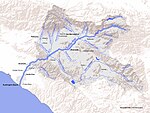2015 San Bernardino attack
On December 2, 2015, a terrorist attack, consisting of a mass shooting and an attempted bombing, occurred at the Inland Regional Center in San Bernardino, California. The perpetrators, Syed Rizwan Farook and Tashfeen Malik, a married couple living in the city of Redlands, targeted a San Bernardino County Department of Public Health training event and Christmas party of about 80 employees in a rented banquet room. Fourteen people were killed and 22 others were seriously injured. Farook was an American born citizen of Pakistani descent, who worked as a health department employee. Malik was a Pakistani-born green card holder. After the shooting, the couple fled in a rented Ford Expedition SUV. Four hours later, police pursued their vehicle and killed them in a shootout, which also left two officers injured. According to the FBI's investigation, the perpetrators were "homegrown violent extremists" inspired by foreign terrorist groups. They were not directed by such groups and were not part of any terrorist cell or network. FBI investigators have said that Farook and Malik had become radicalized over several years prior to the attack, consuming "poison on the internet" and expressing a commitment to jihadism and martyrdom in private messages to each other. Farook and Malik had traveled to Saudi Arabia in the years before the attack. The couple had amassed a large stockpile of weapons, ammunition, and bomb-making equipment in their home. Enrique Marquez Jr., a friend and former neighbor of Farook's, was investigated in connection with his purchase of the two rifles used in the attack. Marquez was arrested in December 2015, and later pleaded guilty to federal charges of providing material support for terrorism and making false statements in connection with the acquisition of a firearm. Marquez also admitted that, in 2011, he conspired with Farook to carry out shooting and bombing attacks, plans which were abandoned at the time. Three other people, including Farook's brother and sister-in-law, were arrested for immigration fraud in connection with a sham marriage between Marquez and Mariya Chernykh (the sister-in-law of Farook's brother). All three pleaded guilty. The attack was the deadliest mass shooting in the U.S. since the 2012 Sandy Hook Elementary School shooting, the deadliest terrorist attack to occur in the U.S. since the September 11 attacks and the deadliest mass shooting in California since the 1984 San Ysidro McDonald's massacre. It was surpassed by the Orlando nightclub shooting in June 2016.
Excerpt from the Wikipedia article 2015 San Bernardino attack (License: CC BY-SA 3.0, Authors).2015 San Bernardino attack
Parkcenter Circle North, San Bernardino
Geographical coordinates (GPS) Address Nearby Places Show on map
Geographical coordinates (GPS)
| Latitude | Longitude |
|---|---|
| N 34.0755 ° | E -117.2777 ° |
Address
Inland Regional Center
Parkcenter Circle North
92354 San Bernardino
California, United States
Open on Google Maps







